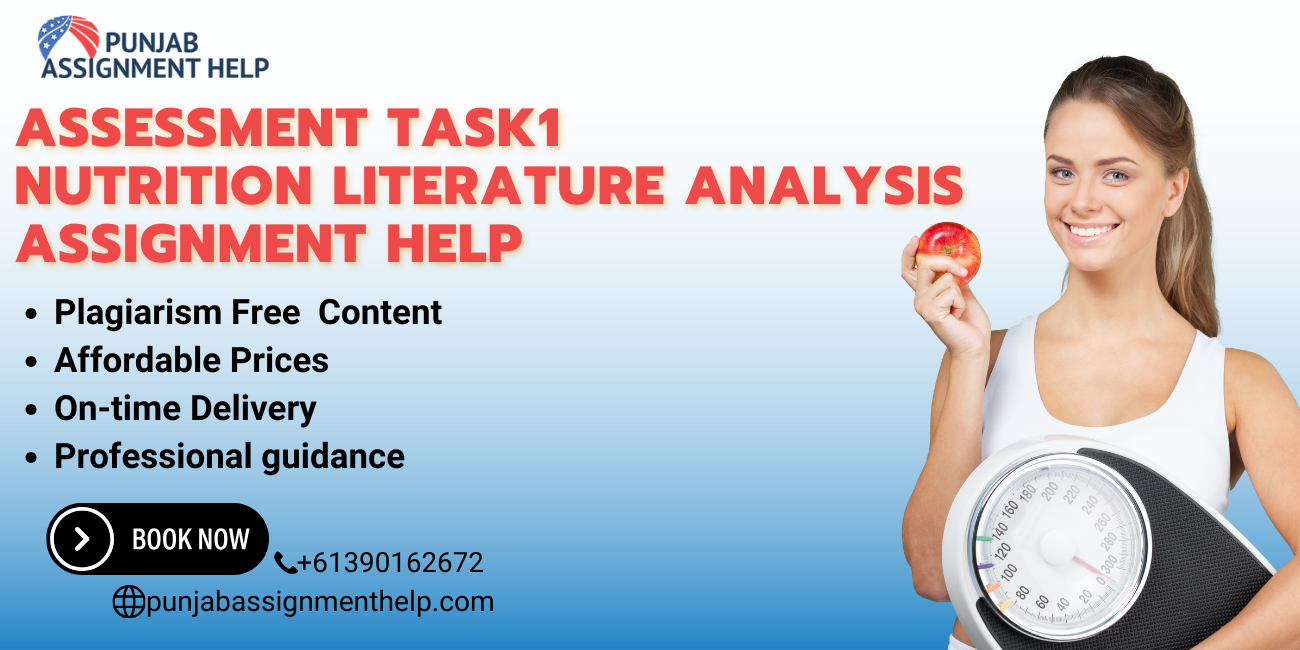
NUTR101
IntroductiontoNutrition
Thefieldofnutritionresearchisyoungbuthasachievedsignificantdiscoveriesover thelast30yearsandhelpedtoimprovepeople’shealth.Weallhaveaviewofhow food relates to health. However, it is important to note, that a personal account of an experience or event is an anecdote and is not acceptable as reliable scientific information. In the Western scientific tradition, a new idea or perspective is generated as a hypothesis that should be testable. Rigorously controlled studies designedtotestthehypothesisareneeded.Thesestudiesformtheevidencebase on which expertsand academicsdraw upon to use in clinical practice andconvey to the general public. This assessment is designed for you to develop an understanding of reliable nutrition information by analysing a journal article and finding credible sources of information.
YoushouldincludeareferencelistusingAPA7convention.Thisshouldbeasingle reference list at the end of the report.
Duedate: SeeCanvas
Weighting: 25%
Lengthand/orformat: Reportstyle,1000words,(includingin-text
citations,excludingreferencelist).Submissions must be in .docx or .pdf only.
Purpose: Enablesstudentstocommunicatereasoningand demonstrate application of knowledge and skills developed in the unit.
Learningoutcomesassessed:LO1,LO2,LO4
How to submit: Submissionofthisassessmenttaskwilloccurvia the Assessment drop box on Canvas.
Return of assignment: Feedbackwillbereturnedwithin3weeksof submission
YouneedtochooseanddownloadONEofthearticleslistedbelowfromthe ACU Library. Carefully read your selected journal article and then use the below to guide your report.
Article1:Kent,K.,Siu,Y.H.,Hutchesson,M.,Collins,C.E.,&Charlton,K.
E.(2024).Associationbetweenfoodinsecuritystatus,campusfoodinitiative use and diet quality in Australian university students. Nutrition &
Dietetics,81(2),170-179.https://doi.org/10.1111/1747-0080.12857
Article2:Kruszewski,M.,Kruszewski,A.,Tabęcki,R.,Kuźmicki,S.,Stec,K., Ambroży,T.,Aksenov,M.O.,Merchelski,M.,&Danielik,T.(2024).Effectivenessof high-fatandhigh-carbohydratedietsonbodycompositionandmaximalstrengthafter 15 weeks of resistance training. Advances in medical sciences, 69(1), 139–146. https://doi.org/10.1016/j.advms.2024.02.008
Thesuggestionsforwordcountareaguide only.
Copythefollowingtableintoyourreport.Entertherelevantinformationintoyour table.
| Firstauthor’sname | |
| Yearof publication | |
| Journal name | |
| Study design |
Explainthepeer-reviewprocessforscientificjournalarticlesandwhyitisimportant. Use references to support your explanation.
Briefly summarise the background literature of your article and explain how it providesarationaleforthestudy.Inyourownwords,identifytheaim/softhestudy.
Arationaleexplainswhythestudyisbeingconductedandtheaimsarethe questions trying to be answered by the study.
Explain the general strengths and weaknesses of using the study design (e.g., case-control,cohort,randomised-controlledtrialetc.)thatyouidentifiedinPart1.
Thisshouldnotbeinreferencetoyourselectedstudy.Referencesshouldbe included to support your explanation.
Explainthemethodsoftheselectedstudy.Yourresponseshouldinclude:
Inyourownwords,summarisethemainfindingsofthestudy.Donotincludeany
tablesorfigures.Includedatafrom thestudywhererelevant.
Reflectonhowthefindingsofthepaperaffectsyourunderstandingofnutrition. Consider whether the findings of the study change your perspective on the nutrition-related issue addressed by the paper.
Youcanconsideraspectssuchas:
Whetherthefindingsofthestudyhavebeensupportedbyother studies
(Doesthispaperalignwithorchallengethecurrentknowledgebase?)
Note: there is no obligation to answer all of the above questions. The above promptsareprovidedtoguideyourreflectionsonthepaperyou’veanalysed.
Thewholereportshouldbewritteninyourownwords.Donotcopy
sectionsoftextfromyourarticleandavoiddirectlyquotingyourarticle.
Assessment criteria (weighting%) | Standardachieved | ||||
| NN(0-49) | P(50-64) | C(65-74) | D(75-84) | HD(85-100) | |
| 1.Journal, author | Submission | Submission | Submission | Submission | Submission |
| informationand | demonstratesvery | demonstrates | demonstratesgood | demonstratesvery | demonstrateshigh- |
| studydesign(5%) | littleunderstandingof | satisfactory | understandingof the | goodunderstanding | level understanding |
| thearticledetailsand | understandingof the | articledetailsand | ofthearticle details | ofthearticle details | |
| study design | articledetailsand | study design | andstudydesign | andstudydesign | |
| study design | |||||
| 2. Peerreview | Submission | Submission | Submission | Submission | Submission |
| (10%) | demonstratesvery | demonstrates | demonstratesgood | demonstratesvery | demonstrateshigh- |
| littleaunderstanding | satisfactory | understandingof the | goodunderstanding | level understanding | |
| ofthepeer-review | understandingof the | peer-reviewprocess, | ofthepeer-review | ofthepeer-review | |
| process,evidenced | peer-reviewprocess, | evidencedwith | process,evidenced | process,evidenced | |
| withlimitedorno | evidencedwith | appropriateliterature | withappropriate | withhighly | |
| appropriateliterature | limitedorno | literature | appropriateliterature | ||
| appropriateliterature | |||||
| 3.Analysisof | Submission | Submission | Submission | Submission | Submission |
| introduction, | demonstratesvery | demonstrates | demonstratesgood | demonstratesvery | demonstrateshigh- |
| rationaleandaim | littleanalysisofthe | satisfactoryanalysis | analysisofthe | goodanalysisofthe | levelanalysisofthe |
| (15%) | introduction,rationale | of the introduction, | introduction, | introduction,rationale | introduction,rationale |
| andaimsofthestudy | rationaleandaimsof | rationaleandaimsof | andaimsofthestudy | andaimsofthestudy | |
| thestudy | thestudy | ||||
| 4.Analysisofstudy | Submission | Submission | Submission | Submission | Submission |
| design(10%) | demonstratesvery | demonstrates | demonstratesgood | demonstratesvery | demonstrateshigh- |
| littleunderstandingof | satisfactory | understandingof the | goodunderstanding | level understanding | |
| thestudy design, | understandingof the | study design, | ofthestudy design, | ofthestudy design, | |
| processwhichis | study design, | processwhichis | processwhichis | processwhichis | |
| evidencedwith | processwhichis | evidencedwith | evidencedwith | evidencedwith highly | |
| limitedorno | evidencedwith | appropriateliterature | appropriateliterature | appropriateliterature | |
| appropriateliterature | limitedorno | ||||
| appropriateliterature | |||||
| 5.Analysisofthe | Submission | Submission | Submission | Submission | Submission |
| methods(10%) | demonstratesvery | demonstrates | demonstratesgood | demonstratesvery | demonstrateshigh- |
| littleanalysisofthe | satisfactoryanalysis | analysisofthe | goodanalysisofthe | levelanalysisofthe | |
| methods | ofthe methods | methods | methods. | methods | |
| 6.Analysisofresults | Submission | Submission | Submission | Submission | Submission |
| (10%) | demonstratesvery | demonstrates | demonstratesgood | demonstratesvery | demonstrateshigh- |
| littleunderstandingof | satisfactory | understandingof the | goodunderstanding | level understanding | |
| thekeyresults. Some | understandingof the | key results. | of thekeyresults. | of thekeyresults. | |
| ornoappropriate | keyresults. Some | Appropriatedatais | Appropriatedatais | Highlyappropriate | |
| datais included. | appropriatedata is | included. | included. | datais included. | |
| included. | |||||
7.Reflectionsand conclusions(20%) | Submission demonstrates little reflection on how understanding of nutritionhaschanged after considering the study.
The reflection considersfewfactors about the study to inform the reflection. | Submission demonstrates a satisfactoryreflection on how understanding of nutritionhaschanged after considering the study. The reflection considers some factors about the studytoinformthe reflection. | Submission demonstrates a somewhat deep reflectiononhow understandingof nutrition has changed after considering the study. The reflection considersarangeof factors about the study to inform the reflection. | Submission demonstratesadeep reflection on how understanding of nutritionhaschanged after considering the study. The reflection considers a wide range of factors about the study to informthereflection. | Submission demonstrates a very deep reflection on howunderstandingof nutritionhaschanged after considering the study. The reflection considers a very widerangeoffactors about the study to informthe reflection. |
5.Referencing (10%) | Incorrect referencing style used, no in-text referencingand/orno reference list evident | Repeated errors in APA7referencingin- text and/or in the reference list | SomeerrorsinAPA7 referencing in-text and/or in the reference list | MinorerrorsinAPA7 referencing in-text and or in the reference list | Very minor errors in APA7referencingin- text and/or in the reference list |
Very limited or no referencelist.Very few sources used were credible
Limitedorno integrationof references | Limitedreferencelist. Few sources used were credible
Limitedintegrationof references | Somewhat detailed referencelist.Some sources used were credible
Satisfactory integrationof references | Detailedreference list. Most sources used are credible
Goodintegrationof references | Very detailed reference list. All sourcesusedare highly credible
Thoroughintegration of references | |
6.Communication (10%) | No proof-reading evident, with many spellingandgrammar errors throughout.
Standardofwritingis very low | Limitedproof-reading evidence, with spelling andgrammar errors throughout.
Standardofwritingis satisfactory | Somespellingand grammar errors throughout.
Standardofwritingis good | Fewspellingand grammar errors throughout.
Standardofwritingis very good | Littletonospelling and/or grammar errors throughout.
Standardofwritingis excellent |
Note:workbeyond+10%ofthewordlimitequivalencewillnotbemarked


Get original papers written according to your instructions and save time for what matters most.